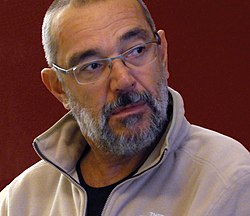Biography
sOURCE: [2]
Andrea Benetti is an Italian painter, photographer and designer, born in Bologna in 1964. In 2006 he authored the Manifesto of Neo-Cave Art, which he presented at the 53rd Venice Biennale of Art in 2009. [3] [4]
His art is inspired by a direct reference and indirectly to the first forms of art made by prehistoric man. From the cave works, Benetti borrowed their stylistic features from a creative point of view, creating works crowded with stylized zoomorphic and anthropomorphic motifs, geometric shapes and abstract shapes, with fields of color, as if to create an ethical and philosophical bridge between prehistory and contemporaneity, emphasized by 'use of vegetable pigments and techniques such as bas-relief and graffiti. [5]
His work is present in the main national and foreign art collections (such as those of the United Nations, the Vatican and the Quirinale), [6] among his most recent exhibitions are "Colors and sounds of the origins" (Bologna, Palazzo D'Accursio, 2013), [7] "VR60768 · anthropomorphic figure" (Rome, Chamber of Deputies, 2015), [8] "Pater Luminum" (Gallipoli, Civic Museum, 2017) and "Faces against violence" (Bologna, Palazzo D'Accursio, 2017). [9] His work is also represented by online galley like Singulart and, selected in curated collections. [10] [11]
In 2020 the artist was awarded the "Nettuno Prize" of the city of Bologna. [12]
This page is based on this
Wikipedia article Text is available under the
CC BY-SA 4.0 license; additional terms may apply.
Images, videos and audio are available under their respective licenses.
